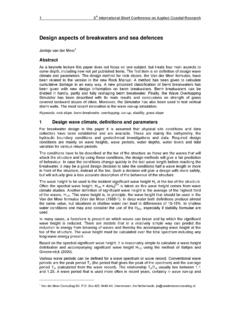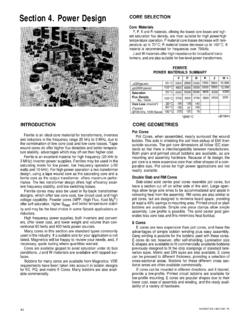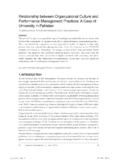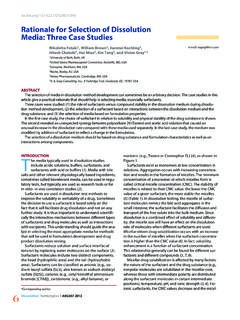Transcription of Application and stability criteria for rock and artificial ...
1 1 CHAPTER 11 Application and stability criteria for rock and artificial units Jentsje W. van der Meer Consultants for Infrastructure appraisal and management, Infram 1 INTRODUCTION The design tools given in this chapter on rubble mound structure armour layers are based on tests of schematised structures. Structures in prototype may differ substantially from the test-sections. Results, based on design tools, can therefore only be used in a conceptual design. The confidence bands, which are given for most formulae, support the fact that reality may differ from the mean curve. It is advised to perform physical model investigations for detailed design of all important rubble mound structures. The armour layer of a rubble mound structure is one of the most important parts to design.
2 Under-design of this layer may consequently lead to large damage or even failure of the structure. Three types of armour layers for seawalls and revetments will be described: rock layers concrete armour units berm type protection The chapter will start with a description of some basic parameters used in design of armour layers and will finish with stepped and composite slopes. 2 BASIC PARAMETERS Wave conditions are given principally by the incident wave height at the toe of the structure, H, usually as the significant wave height, Hs (average of the highest 1/3 of the waves) or Hm0 (based on the spectrum); the mean or peak wave periods, Tm or Tp (based on statistical or spectral analysis); the angle of wave attack, , and the water depth, h.
3 The wave height distribution at deep water can be described by the Rayleigh distribution and in that case one characteristic value, for instance the significant wave height, describes the whole distribution. In shallow and depth limited water the highest waves break and in most cases the wave height distributions cannot longer be described by the Rayleigh distribution. In those situations the actual wave height distribution may be important to consider, or another characteristic value than the significant wave height. Characteristic values that are often used are the two-percent wave height, H2%, and the H1/10, being the average of the highest ten percent of the waves. For a Rayleigh distribution the values H2% = Hs and H1/10 = Hs hold.
4 2 The influence of the wave period is often described as a wave length and related to the wave height, resulting in a wave steepness. The wave steepness, s, can be defined by using the deep water wave length, gTH2 = s2 (1) If the situation considered is not really in deep water (in most cases) the wave length at deep water and at the structure differ and, therefore, a fictitious wave steepness is obtained. In fact the wave steepness as defined in equation 1 describes a dimensionless wave period.
5 Use of Hs and Tm or Tp in this equation gives a subscript to s, respectively som and sop. The most useful parameter describing wave action on a slope, and some of its effects, is the breaker parameter : s / tan= (2) The breaker parameter has often been used to describe the form of wave breaking on a beach or structure, see chapters 2 and 8. It should be noted that different versions of this parameter are defined, reflecting the approaches of different researchers. In this chapter m and p are used when s is described by som or sop.
6 The most important parameter which gives a relationship between the structure and the wave conditions is the stability number Hs/ Dn50. The relative buoyant density in here is described by: 1 - = wr (3) where: r = mass density of the rock or concrete (saturated surface dry mass density), w = mass density of water. The diameter used is related to the average mass of the rock and is called the nominal diameter: r503/150nM = D (4) where: Dn50 = nominal diameter, M50 = median mass of rock grading given by 50% on the mass distribution curve.
7 With the use of concrete units there is only one mass and no grading. This means that the nominal diameter and the stability number are described without the subscript 50, giving Dn and Hs/ Dn, respectively. 3 3 ROCK ARMOUR LAYERS Hudson formula Many methods for the prediction of (rock) size of armour units designed for wave attack have been proposed in the last 50 years. Those treated in more detail here are the Hudson formula as used in SPM (1984) and the formulae derived by Van der Meer (1988a). The Hudson formula written in its most simple form is: Hs/ Dn50 = (KD cot )1/3 (5) KD is a stability coefficient taking into account all other variables. KD-values suggested for design correspond to a "no damage" condition where up to 5% of the armour units may be displaced.
8 In the 1973 edition of the Shore Protection Manual the values given for KD for rough, angular stone in two layers on a breakwater trunk were: KD = for breaking waves, KD = for non-breaking waves. The definition of breaking and non-breaking waves is different from plunging and surging waves, which were described in chapters 2 and 8. A breaking wave in equation 5 means that the wave breaks due to the foreshore in front of the structure directly on the armour layer. It does not describe the type of breaking due to the slope of the structure itself. No tests with random waves had been conducted and it was suggested to use Hs in equation 5. By 1984 the advice given was more cautious. The SPM now recommends H = H1/10 being the average of the highest 10 percent of all waves.
9 For the case considered above the value of KD for breaking waves was revised downward from to (for non-breaking waves it remained ). The effect of these two changes is equivalent to an increase in the unit stone mass required by a factor of about ! The main advantages of the Hudson formula are its simplicity, and the wide range of armour units and configurations for which values of KD have been derived. The Hudson formula also has many limitations. Briefly they include: the use of regular waves only, no account taken in the formula of wave period or storm duration, no description of the damage level, the use of non-overtopped and permeable core structures only. The use of KD cot does not always best describe the effect of the slope angle.
10 It may therefore be convenient to define a single stability number Hs/ Dn50 without this KD cot . Van der Meer formulae - deep water conditions Based on earlier work of Thompson and Shuttler (1975) an extensive series of model tests was conducted at Delft Hydraulics (Van der Meer (1988a), Van der Meer (1987), Van der Meer (1988b)). These include structures with a wide range of core/underlayer permeabilities and a wider range of wave conditions. Two formulae were derived for plunging and surging waves, respectively, which are now known as the Van der Meer formulae: 4 for plunging waves: NS P = DH (6) and for surging waves: cot NS P = DH (7) where.











